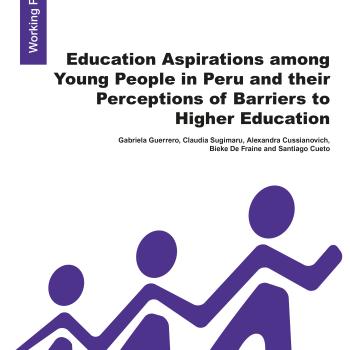Publication Information

Data from the Young Lives survey in Peru show there is a gap between young people’s aspirations for higher education and their actual chances of accessing university or college. This paper uses qualitative information from Young Lives in order to gain a deeper understanding of young people’s aspirations as well as their views of the main barriers they face. We analyse how aspirations are formed, to what extent they are related to parents’ educational aspirations for their children, and if they are stable or tend to change over time.
We find high aspirations among low-income young people and their caregivers and establish that education is highly valued by Peruvian families. Young people’s aspirations are influenced by their caregivers’ educational history and experiences. The longitudinal nature of the data, both quantitative and qualitative, allowed us to identify that young people’s, and particularly caregivers’, educational aspirations changed over time, mainly in response to changes in the family’s socio-economic circumstances.
The study also identified several barriers preventing low-income youth in urban and rural areas from realising their educational aspirations. Besides economic and psychological barriers (mainly experienced as lack of family support), the papers points to the existence of additional barriers such as a lack of information available to secondary school students, and their parents, about higher education (what and where to study and how to apply) and the fact that schools do not play an active role in preparing students for a transition to higher education. Based on their findings, the authors discuss some policy recommendations aimed at overcoming those barriers.

Data from the Young Lives survey in Peru show there is a gap between young people’s aspirations for higher education and their actual chances of accessing university or college. This paper uses qualitative information from Young Lives in order to gain a deeper understanding of young people’s aspirations as well as their views of the main barriers they face. We analyse how aspirations are formed, to what extent they are related to parents’ educational aspirations for their children, and if they are stable or tend to change over time.
We find high aspirations among low-income young people and their caregivers and establish that education is highly valued by Peruvian families. Young people’s aspirations are influenced by their caregivers’ educational history and experiences. The longitudinal nature of the data, both quantitative and qualitative, allowed us to identify that young people’s, and particularly caregivers’, educational aspirations changed over time, mainly in response to changes in the family’s socio-economic circumstances.
The study also identified several barriers preventing low-income youth in urban and rural areas from realising their educational aspirations. Besides economic and psychological barriers (mainly experienced as lack of family support), the papers points to the existence of additional barriers such as a lack of information available to secondary school students, and their parents, about higher education (what and where to study and how to apply) and the fact that schools do not play an active role in preparing students for a transition to higher education. Based on their findings, the authors discuss some policy recommendations aimed at overcoming those barriers.

